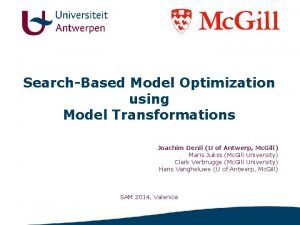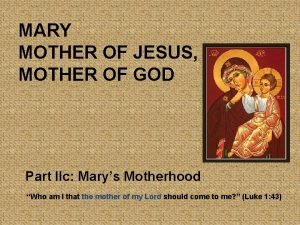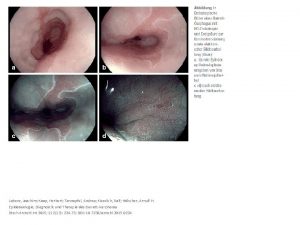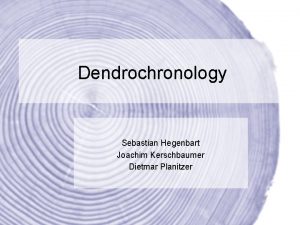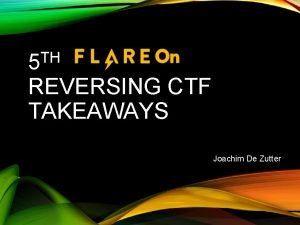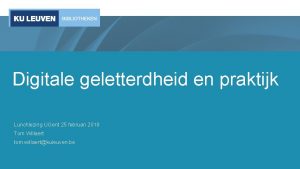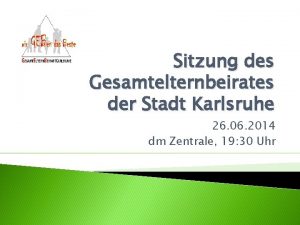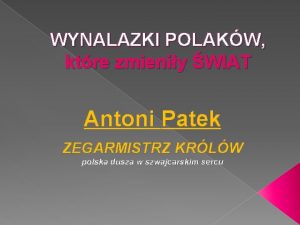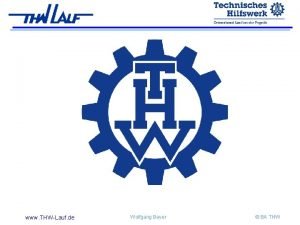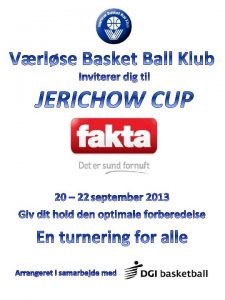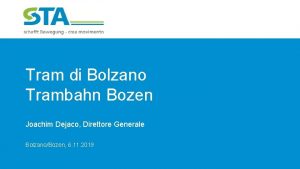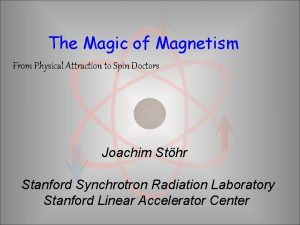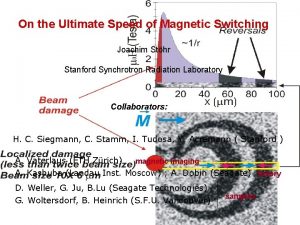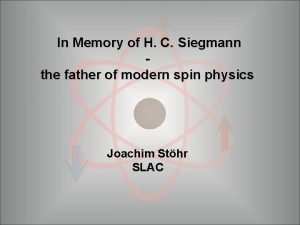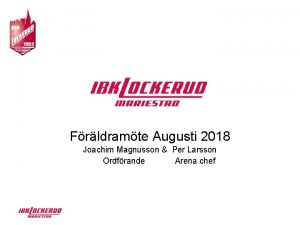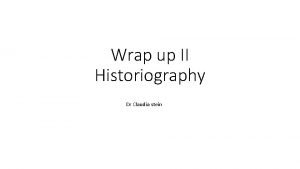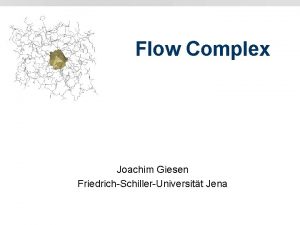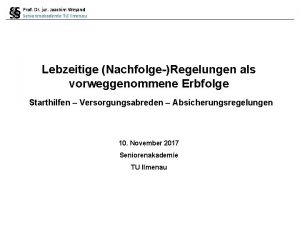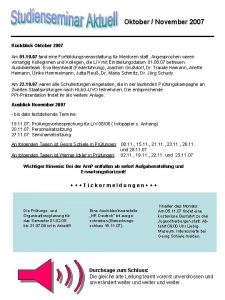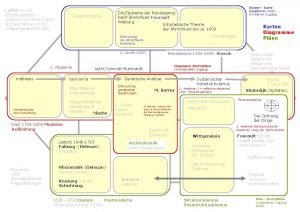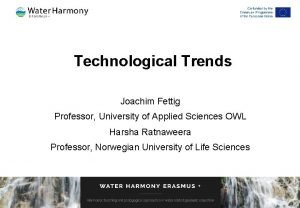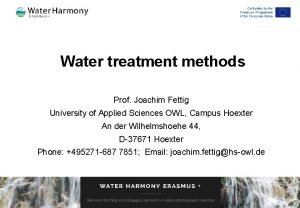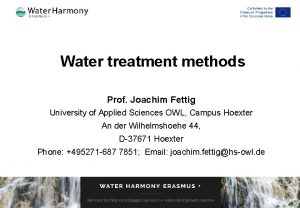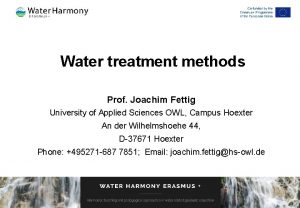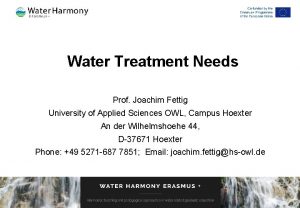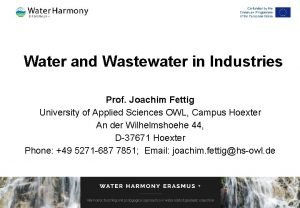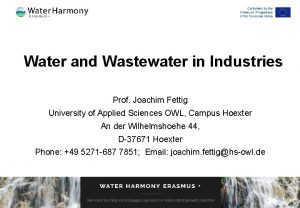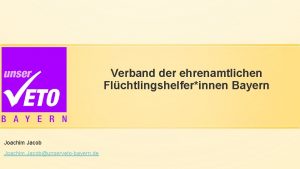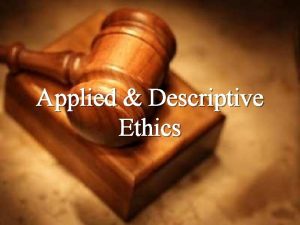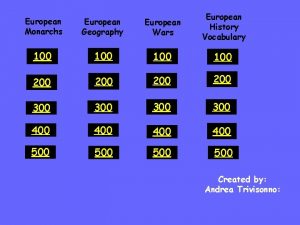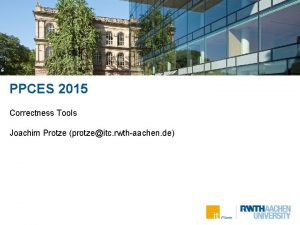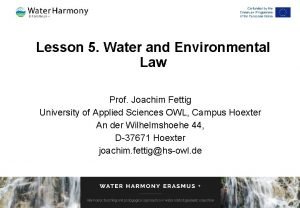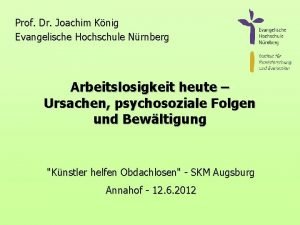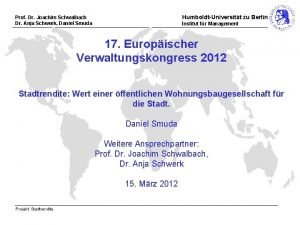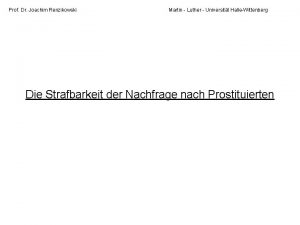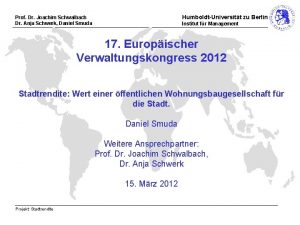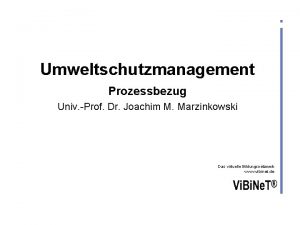European Tools Prof Joachim Fettig University of Applied




















- Slides: 20

European Tools Prof. Joachim Fettig University of Applied Sciences OWL, Campus Hoexter An der Wilhelmshoehe 44, D-37671 Hoexter Phone: +49 5271 -687 7851; Email: joachim. fettig@hs-owl. de

Outline - Overview of relevant EU-Directives - EU-Directive 2010/75/EU on Industrial Emissions - BAT- Best Available Techniques § Background § Application and control § Example: Chemical sector - Implementation at the national level - Final remarks European Tools 2

Overview of relevant EU-Directives § European Water Framework Directive 2000/60/EC (see lesson 3) → Control of point and diffuse emission sources → Development of strategies against pollution of natural waters § European Urban Waste Water Treatment Directive 91/271/EEC, amended by Directive 98/15/EC (see lesson 3) → Obligation to establish national regulations for industrial wastewater discharged directly into receiving waters → Pre-treatment of industrial wastewater discharged into public sewers § Directive 2010/75/EU on Industrial Emissions (IED) → Revision of the former Directive 2008/1/EC concerning integrated pollution prevention and control (IPPC) European Tools 3

Directive 2010/75/EU on Industrial Emissions General idea Ø To control industrial emissions, the EU has developed a general framework based on integrated permitting. This means the permits must take account of a plant’s complete environmental performance to avoid pollution being shifted from one medium - such as air, water and land - to another. Ø Priority should be given to preventing pollution by intervening at source and ensuring prudent use and management of natural resources. Ø The main goal is an integrated pollution prevention and control. European Tools 4

Directive 2010/75/EU on Industrial Emissions What does the Directive do? - It is a recast of 7 earlier pieces of legislation on industrial emissions. - It lays down rules to prevent and control pollution into air, water and land to avoid generating waste from large industrial installations. Key points: § The legislation covers the following industrial activities: Energy, metal production and processing, minerals, chemicals, waste management and other sectors such as pulp and paper production, slaughterhouses and the intensive rearing of poultry and pigs. European Tools 5

Directive 2010/75/EU on Industrial Emissions Key points (contd. ): § All installations covered by the directive must prevent and reduce pollution by applying the best available techniques (BATs), efficient energy use, waste prevention and management and measures to prevent accidents and limit their consequences. § The installations can only operate if they are in possession of a permit, and if they comply with the conditions set therein. These requirements are mandatory. European Tools 6

Directive 2010/75/EU on Industrial Emissions Key points (contd. ): § The BAT conclusions adopted by the Commission are the reference for setting the permit conditions. Emission limit values must be set at a level that ensures pollutant emissions do not exceed the levels associated with the use of BATs. However they may, if it is proven that this would lead to disproportionate costs compared to environmental benefits. § Competent authorities need to conduct regular inspections of the installations. § The public must be given an early opportunity to participate in the permitting process (obligation to access to information). European Tools 7

Best available techniques (BATs) Background: Ø BATs are defined as the most effective techniques for preventing or reducing emissions that are technically feasible and economically viable within the sector. Ø BAT Reference documents (BREFs) are drawn up, reviewed and updated by panels that include national experts, the respective industries concerned, NGOs and the European Commission. The activities are coordinated by the IPPC Bureau in Sevilla/Spain (http: //eippcb. jrc. europa. eu). Ø From the BREFs, BAT conclusions are derived that must formally be adopted by the European Commission. European Tools 8

Best available techniques (BATs) Overview over currently*) available BREFs: § Ceramic Manufacturing Industry § Common Waste Water and Waste Gas Treatment/Management Systems in the Chemical Sector § Emissions from Storage § Energy Efficiency § Industrial Cooling Systems § Intensive Rearing of Poultry or Pigs § Iron and Steel Production § Large Volume Inorganic Chemicals - Ammonia, Acids and Fertilisers Industries *) October 2017 European Tools 9

Best available techniques (BATs) Overview over currently available BREFs (contd. ): § § § § § Large Volume Inorganic Chemicals - Solids and Others Industry Manufacture of Glass Manufacture of Organic Fine Chemicals Non-ferrous Metals Industries Cement, Lime and Magnesium Oxide Manufacturing Industries Production of Chlor-alkali Production of Polymers Production of Pulp, Paper and Board Production of Speciality Inorganic Chemicals Refining of Mineral Oil and Gas European Tools 10

Best available techniques (BATs) Overview over currently available BREFs (contd. ): § § § Slaughterhouses and Animals By-products Industries Smitheries and Foundries Industry Surface Treatment of Metals and Plastics Tanning of Hides and Skins Wood-based Panels Production Economics and Cross-media Effects In addition to these 24 documents, another 10 BREFs are in preparation, e. g. for § Food, Drink and Milk Industries § Large Volume Organic Chemical Industry European Tools 11

Best available techniques (BATs) Application and control: Ø BAT conclusions shall be the reference for setting the permit conditions in the member states. Ø If an environmental standard requires stricter conditions than those achievable by the use of BATs, additional measures shall be included in the permit. Ø The member states shall encourage further development and application of emerging techniques identified in the BREFs. Ø Member states shall set up a system of environmental inspections of installations which should include site visits and be carried out in intervals between 1 and 3 years. European Tools 12

Best available techniques (BATs) Example: Water relevant BAT conclusions, based on the Commission implementing decision (EU) 2016/902 of 30 May 2016, establishing BAT Conclusions for Common Wastewater and Waste Gas Treatment/ Management Systems in the Chemical Sector Ø BAT 1: Implementation of an environmental management system (EMS) Ø BAT 2: Establishment of an inventory of wastewater and waste gas streams Ø BAT 3: For relevant emissions to water, monitoring of key process parameters (including continuous monitoring of wastewater flow, p. H and temperature) at key locations (e. g. influent to pretreatment and influent to final treatment) Ø BAT 4: Monitoring of emissions to water in accordance with EN standards with minimum frequencies of daily (TOC, COD, TSS, TN, Ninorg, TP), monthly (AOX and heavy metals) and to be decided individually (toxicity). European Tools 13

Best available techniques (BATs) Example: Water relevant BAT conclusions in the chemical sector (contd. ) Ø BAT 5 and 6: Related to emissions into air, not relevant for water. Ø BAT 7: Reduction of the volume and/or pollutant load of wastewater streams, enhancement of the reuse of wastewater within the production process and recovering and reuse of raw materials Ø BAT 8: Segregation of uncontaminated wastewater streams from wastewater streams that require treatment Ø BAT 9: Provision of an appropriate buffer storage capacity for wastewater incurred during other than normal operating conditions based on a risk assessment (taking into account e. g. the nature of the pollutant, the effects on further treatment, and the receiving environment), and appropriate further measures (e. g. control, treat, reuse). European Tools 14

Best available techniques (BATs) Example: Water relevant BAT conclusions in the chemical sector (contd. ) Ø BAT 10: Use of an integrated wastewater management and treatment strategy that includes an appropriate combination of techniques in the following priority order: • Process-integrated techniques • Recovery of pollutants at source • Wastewater pretreatment • Final wastewater treatment Ø BAT 11: Pretreatment of wastewater containing pollutants that cannot be dealt with adequately during final wastewater treatment Ø BAT 12: Use of an appropriate combination of final wastewater treatment techniques (mechanical, biological and chemical processes) European Tools 15

Best available techniques (BATs) Example: Water relevant BAT conclusions in the chemical sector (contd. ) BAT-associated emission levels (BAT-AELs) are yearly-average values for direct emissions to a receiving water body. They comprise: Organics and particles Nutrients Halogens and heavy metals TOC = 10 – 33 mg/L TN = 4 – 25 mg/L AOX = 0. 2 – 1 mg/L COD = 30 – 100 mg/L Ninorg = 5 – 20 mg/L Cr, Cu, Ni = 5 – 25 (50) mg/L TSS = 5 – 35 mg/L TP = 0. 5 – 3 mg/L Zn = 20 – 300 mg/L Note: 1. The values apply only if minimum annual loads are exceeded. 2. The upper and lower end of the ranges are related to certain wastewater compositions and treatment techniques applied. European Tools 16

Implementation at the national level Example Germany: State Decrees for the environmental inspection of industrial installations (including wastewater treatment plants) Approach: → Authorities conduct regular inspections of industrial installations (every 1 – 3 years) → They estimate the environmental impact and check whether all requirements are met. → In case of severe problems a new inspection takes place after 6 months. → A report is prepared to the EU that is made available to the public within 4 months. European Tools 17

Implementation at the national level Example Germany: Federal Ordinance for the Permission and Monitoring of industrial wastewater treatment plants (2017) Content: → Description of the application procedure → Participation of the public and provision of information → Conditions for permission and approval → Monitoring conditions and monitoring plans for plants that are in operation → Practical execution of monitoring and control European Tools 18

Implementation at the national level Example Germany: German Wastewater Ordinance (2004) Purpose: Specification of the minimum requirements on treated wastewater for direct discharge into a water body → Pollutant load must be kept as low as the use of water-saving processes permits (general requirement). → Effluent concentrations must comply with threshold values given for 52 industrial sources of wastewater plus domestic wastewater. → The threshold values must be in agreement with the BAT-associated emissions levels given in the BREFs for the respective industry. European Tools 19

Final remarks § EU’s Industrial Emission Directive is based on the principle of integrated pollution prevention and control. § It starts with defining procedures for permitting and monitoring of industrial installations, including regular inspections by authorities and reporting to the EU and to the public. § The best available techniques (BAT) concept plays a key role in this approach because companies must comply when applying for permits. § The respective documents (BREFs) are developed by panels where all stakeholders participate. § The emission situation in Europe is becoming more transparent. European Tools 20
 Clark verbrugge
Clark verbrugge Are heli and joachim the same person
Are heli and joachim the same person Osophagas
Osophagas Joachim kerschbaumer
Joachim kerschbaumer Pronote authon du perche
Pronote authon du perche Fireeye ctf
Fireeye ctf Joachim bovin
Joachim bovin Joachim frisch karlsruhe
Joachim frisch karlsruhe Antoni patek anna piasecka
Antoni patek anna piasecka Thw lauf
Thw lauf Joachim jerichow
Joachim jerichow Joachim dejaco
Joachim dejaco Joachim stöhr
Joachim stöhr Joachim stöhr
Joachim stöhr Joachim stöhr
Joachim stöhr Joachim magnusson mariestad
Joachim magnusson mariestad Joachim haeberlen
Joachim haeberlen Joachim giesen
Joachim giesen Joachim weyand
Joachim weyand Joachim grußdorf
Joachim grußdorf +1202
+1202
